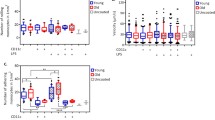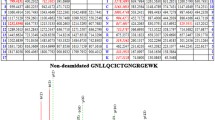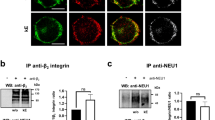Abstract
Low density lipoprotein (LDL) is retained in the extracellular matrix of the arterial wall where it is considered to be atherogenic, but little is known about how cell adhesion to the matrix is affected by collagen-bound LDL. We tested the effect of native, oxidized and acetylated LDL reacted with adsorbed monomeric type I, III and V collagen on endothelial cell adhesion to collagen using a colorimetric adhesion assay. We found that none of the LDL species affected adhesion to type I and III collagen, but that collagen-bound native and acetylated LDL enhanced attachment to type V collagen, whereas bound oxidized LDL inhibited adhesion to this collagen. We therefore suggest that oxidized LDL associated with type V collagen in the arterial wall would favor de-endothelialization and contribute to atherogenesis and thrombosis.
Similar content being viewed by others
References
Hajjar D.P., Haberland M.E., Lipoprotein trafficking in vascular cells. Molecular Trojan horses and cellular saboteurs, J. Biol. Chem., 1997, 272, 22975–22978
Chisolm G.M., Penn M.S., Oxidized Lipoproteins and Atherosclerosis, In: Fuster V., Ross R., Topol E.J., (Eds.), Atherosclerosis and Coronary Heart Disease, Lippincott Raven, Philadelphia, 1996
Ross R., Cell biology of atherosclerosis, Annu. Rev. Physiol., 1995, 57, 791–804
Thorne S.A., Abbot S.E., Winyard P.G., Blake D.R., Mills P.G., Extent of oxidative modification of low density lipoprotein determines the degree of cytotoxicity to human coronary artery cells, Heart, 1996, 75, 11–16
Auerbach, B.J., Bisgaier, C.L., Wolle J., Saxena U., Oxidation of low density lipoproteins greatly enhances their association with lipoprotein lipase anchored to endothelial cell matrix, J. Biol. Chem., 1996, 271, 1329–1335
Edwards I.J., Goldberg I.J., Parks J.S., Xu H., Wagner W.D., Lipoprotein lipase enhances the interaction of low density lipoproteins with arteryderived extracellular matrix proteoglycans, J. Lipid Res., 1993, 34, 1155–1163
Kaplan M., Aviram M., Oxidized LDL binding to a macrophage-secreted extracellular matrix, Biochem. Biophys. Res. Commun., 1997, 237, 271–276
Saxena U., Klein M.G., Vanni T.M., Goldberg I.J., Lipo-protein lipase increases low density lipoprotein retention by subendothelial cell matrix, J. Clin. Invest., 1992, 89, 373–380
Tabas I., Li Y., Brocia R.W., Xu S.W., Swenson T.L., Williams K.J., Lipoprotein lipase and sphingomyelinase synergistically enhance the association of atherogenic lipoproteins with smooth muscle cells and extracellular matrix. A possible mechanism for low density lipoprotein and lipoprotein(a) retention and macrophage foam cell formation, J. Biol. Chem., 1993, 268, 20419–20432
Pillarisetti S., Paka L., Obunike J.C., Berglund L., Goldberg I.J., Subendothelial retention of lipoprotein (a). Evidence that reduced heparan sulfate promotes lipoprotein binding to subendothelial matrix, J. Clin. Invest., 1997, 100, 867–874
Pentikainen M.O., Oorni K., Lassila R., Kovanen P.T., The proteoglycan decorin links low density lipoproteins with collagen type I, J. Biol. Chem., 1997, 272, 7633–7638
Hoover G.A., McCormick S., Kalant N., Interaction of native and cell-modified low density lipoprotein with collagen gel, Arteriosclerosis, 1988, 8, 525–534
Kalant N., McCormick S., Parniak M.A., Effects of copper and histidine on oxidative modification of low density lipoprotein and its subsequent binding to collagen, Arterioscler. Thromb., 1991, 11, 1322–1329
Jimi S., Sakata N., Matunaga A., Takebayashi S., Low density lipoproteins bind more to type I and III collagens by negative charge-dependent mechanisms than to type IV and V collagens, Atherosclerosis, 1994, 107, 109–116
Greilberger J., Schmut O., Jurgens G., In vitro interactions of oxidatively modified LDL with type I, II, III, IV and V collagen, laminin, fibronectin, and poly-D-lysine, Arterioscler. Thromb. Vascular Biol., 1997, 17, 2721–2728
Takei A., Huang Y., Lopes-Virella M.F., Expression of adhesion molecules by human endothelial cells exposed to oxidized low density lipoprotein. Influences of degree of oxidation and location of oxidized LDL, Atherosclerosis, 2001, 154, 79–86
Rauterberg J., Allmann H., Henkel W., Fietzek P.P., Isolation and characterization of CNBr derived peptides of the alpha1 (III) chain of pepsinsolubilized calf skin collagen, Hoppe Seylers Z. Physiol. Chem., 1976, 357, 1401–1407
Rhodes R.K., Miller E.J., Physicochemical characterization and molecular organization of the collagen A and B chains, Biochemistry, 1978, 17, 3442–3448
Kleinveld H.A., Hak-Lemmers H.L., Stalenhoef A.F., Demacker P.N., Improved measurement of lowdensity-lipoprotein susceptibility to copper-induced oxidation: application of a short procedure for isolating low-density lipoprotein, Clin. Chem., 1992, 38, 2066–2072
Thomas C.E., Jackson R.L., Lipid hydroperoxide involvement in copper-dependent and independent oxidation of low density lipoproteins, J. Pharmacol. Exp. Ther., 1991, 256, 1182–1188
Zhang M.Y., Lin R.C., Oxidative-modified and acetylated low-density lipoproteins differ in their effects on cholesterol synthesis and stimulate synthesis of apolipoprotein E in rat peritoneal macrophages by different mechanisms, Metabolism, 1994, 43, 1523–1530
Kueng W., Silber E., Eppenberger U., Quantification of cells cultured on 96-well plates, Anal. Biochem., 1989, 182, 16–19
De-Rijke Y.B., Biessen E.A., Vogelezang C.J., van-Berkel T.J., Binding characteristics of scavenger receptors on liver endothelial and Kupffer cells or modified low-density lipoproteins, Biochem. J., 1994, 304, 69–73
Tanaka T., Nishikawa A., Tanaka Y., Nakamura H., Kodama T., Imanishi T., Doi T., Synthetic collagenlike domain derived from the macrophage scavenger receptor binds acetylated low-density lipoprotein in vitro, Protein Eng., 1996, 9, 307–313
Lougheed M., Steinbrecher U.P., Mechanism of uptake of copper-oxidized low density lipoprotein in macrophages is dependent on its extent of oxidation, J. Biol. Chem., 1996, 271, 11798–11805
Birk D.E., Fitch J.M., Babiarz J.P., Doane K.J., Linsenmayer T.F., Collagen fibrillogenesis in vitro: interaction of types I and V collagen regulates fibril diameter, J. Cell Sci., 1990, 95, 649–657
Marchant J.K., Hahn R.A., Linsenmayer T.F., Birk D.E., Reduction of type V collagen using a dominant-negative strategy alters the regulation of fibrillogenesis and results in the loss of cornealspecific fibril morphology, J. Cell Biol., 1996, 135, 1415–1426
Hashimoto K., Hatai M., Yaoi Y., Inhibition of cell adhesion by type V collagen, Cell. Struct. Funct., 1991, 16, 391–397
Saelman E.U., Nieuwenhuis H.K., Hese K.M., de-Groot P.G., Heijnen H.F., Sage E.H., et al., Platelet adhesion to collagen types I through VIII under conditions of stasis and flow is mediated by GPIa/IIa (alpha 2 beta 1-integrin), Blood, 1994, 83, 1244–1250
Sakata N., Jimi S., Takebayashi S., Marques M.A., Type V collagen represses the attachment, spread, and growth of porcine vascular smooth muscle cells in vitro, Exp. Mol. Pathol., 1992, 56, 20–36
Underwood P.A., Bean P.A., Whitelock J.M., Inhibition of endothelial cell adhesion and proliferation by extracellular matrix from vascular smooth muscle cells: role of type V collagen, Atherosclerosis, 1998, 141, 141–152
Ziats N.P., Anderson J.M., Human vascular endothelial cell attachment and growth inhibition by type V collagen, J. Vasc. Surg., 1993, 17, 710–718
Murata K., Motoyama T., Collagen species in various sized human arteries and their changes with intimal proliferation, Artery, 1990, 17, 96–106
Katsuda S., Okada Y., Minamoto T., Oda Y., Matsui Y., Nakanishi I., Collagens in human atherosclerosis. Immunohistochemical analysis using collagen typespecific antibodies, Arterioscler. Thromb., 1992, 12, 494–502
Sage H., Pritzl P., Bornstein P., Characterization of cell matrix associated collagens synthesized by aortic endothelial cells in culture, Biochemistry, 1981, 20, 436–442
Shekhonin B.V., Domogatsky S.P., Muzykantov V.R., Idelson G.L., Rukosuev V.S., Distribution of type I, III, IV and V collagen in normal and atherosclerotic human arterial wall: immunomorphological characteristics, Coll. Relat. Res., 1985, 5, 355–368
Shekhonin B.V., Domogatsky S.P., Idelson G.L., Koteliansky V.E., Rukosuev V.S., Relative distribution of fibronectin and type I, III, IV, V collagens in normal and atherosclerotic intima of human arteries, Atherosclerosis, 1987, 67, 9–16
Van Zanten G.H., de Graaf S., Slootweg P.J., Heijnen H.F., Connolly T.M., de Groot P.G., Sixma J.J., Increased platelet deposition on atherosclerotic coronary arteries, J. Clin. Invest., 1994, 93, 615–632
Virmani R., Kolodgie F.D., Burke A.P., Farb A., Schwartz S.M., Lessons from sudden coronary death: a comprehensive morphological classification scheme for atherosclerotic lesions, Arterioscler. Thromb. Vasc. Biol., 2000, 20, 1262–1275
Author information
Authors and Affiliations
Corresponding author
About this article
Cite this article
Lorkowski, S., Rauterberg, J., Harrach-Ruprecht, B. et al. Collagen-bound LDL modifies endothelial cell adhesion to type V collagen: Implications for atherosclerosis. cent.eur.j.biol. 4, 536–542 (2009). https://doi.org/10.2478/s11535-009-0047-8
Received:
Accepted:
Published:
Issue Date:
DOI: https://doi.org/10.2478/s11535-009-0047-8




